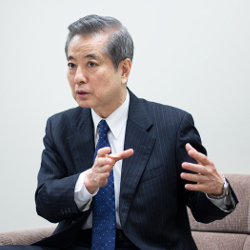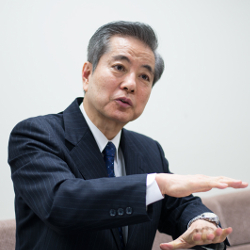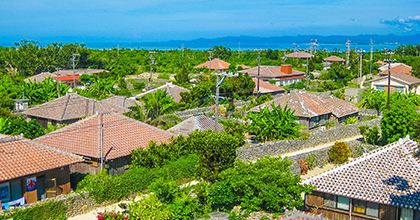Providing low-cost per capita prefectural government services

When thinking about Okinawa’s economy, it is important to understand the fiscal relations between the central government and local governments. Everyone probably knows that the central government provides aid to not only Okinawa but all local governments—prefectural and municipal governments. Around 30% of the national budget is distributed to local governments in various forms, including local allocation tax grants (chihokofuzei) and national government-disbursement (kokkoshishutsukin). The amount of local allocation tax grants reaches 17 trillion yen annually, but how that money is allocated is not well known. In fact, the Ministry of Internal Affairs and Communications objectively calculates a financial capability index for local governments, and uses that index to distribute local allocation tax grants. The financial capability index is calculated by dividing standard financial revenue by standard financial need. In other words, it indicates standard revenue compared to standard expenditures necessary for the local government to provide services. If the financial capability index for a particular local government is 1.0 or greater, that local government can cover the services it provides with tax revenue. Prefectures with a financial capability index less than 0.3 are categorized as group E prefectures, the lowest rank, and there are ten prefectures, including Okinawa, that fall in this group (as of fiscal 2013). The local allocation tax grants system is such that the weaker a prefecture is financially, the more local allocation tax grants it receives. This is because the local allocation tax grants are to correct differences in financial capability and ensure financial resources. One can argue that Japan’s system places greater emphasis on fairness than efficiency. Because of this, no matter where a person lives in Japan, they receive about the same level of government services. On the other hand, because Japanese can receive a certain level of government services without having to try to increase tax revenue, they are victims of a financial illusion—that is, they do not possess a very strong awareness that government services are paid for by taxes. There is little awareness that the burden should equal the benefits, and this is probably at the root of how people who do not live in Okinawa also feel about the issue of the U.S. military bases in Okinawa.
Let’s compare the ten prefectures in group E, those with the lowest financial capability index. If the average standard financial revenue for those ten prefectures is 100.0, Okinawa’s standard financial revenue would be 83.4, the lowest among the ten prefectures. However, the average financial capability index for those ten prefectures is 0.27405, and that for Okinawa is 0.28855, which is greater than the average. If you ask why, the reason is that Okinawa has low standard financial need —standard expenditures; if the average standard financial need for the ten prefectures in group E is 100.00, that for Okinawa is 77.5. You would probably not understand the reason for that if you did not understand the distinctive aspects of Okinawa’s population distribution. In fact, of the 1.45 million residents of Okinawa, about 1.2 million live in the southern central part of the main island. Therefore, government services can be provided extremely efficiently. Incidentally, Okinawa is ranked 43rd among the 47 prefectures in terms of financial capability index but 17th in terms of per capita local allocation tax grants. Compared to other local governments that have numerous sparsely populated areas, for Okinawa, the expenditures necessary to undertake various activities ranging from providing education and welfare services to building roads is extremely low. If one considers per capita expenses, while average education expenses for the ten group E prefectures is 109,048 yen, it is only 104, 915 yen for Okinawa, and although the average civil engineering expenses for those same prefectures is 80,366 yen, it is 58,950 yen for Okinawa. Okinawa is ranked 21st in terms of per capita civil engineering expenses among the various prefectures, placing it in the middle of the pack. Furthermore, in terms of investment expenses, the average for the ten group E prefectures is 118,487 yen, but 110,753 yen for Okinawa. It seems that many people think that Okinawa’s economy is supported by public works projects much more than other prefectures, but that is not true.
In this way, the system of local allocation tax grants is such that the weaker a local government is financially, the more local allocation tax grants it receives. Okinawa, which belongs to the group of prefectures with the lowest financial capability indexes, receives a lot of local allocation tax grants, but compared to other prefectures in the same group, it does not receive a particularly large amount.
The Okinawa promotion budge is equivalent to national government funds provided to all prefectures
Next, there are national-government disbursements. These are subsidies disbursed to local governments by national government for particular purposes, and their purpose is always to implement the central government policy. The subsidies are provided by the various ministries, and each prefecture requests a budget from the particular ministry. For Okinawa, however, the Act on Special Measures for the Promotion and Development of Okinawa stipulates a mechanism so that subsidies are provided in a lump sum as the budget for the Cabinet Office bureau responsible for Okinawa. The total of national-government disbursements paid in a lump sum and cost of national government projects are referred to as the Okinawa promotion budget. In other words, it is called the Okinawa promotion budget, but it is simply the sum of national government disbursements and the cost of national government projects, which all prefectures receive. Even so, Okinawa ranks 4th among the 47 prefectures in terms of the per capita national-government disbursements. In addition, a lot of the budget is distributed for operations such as maintaining Naha Airport and Miyakojima Airport and constructing a new airport for the Yaeyama islands. These airports, of course, are also used by commercial airplanes, but a major purpose for them is national defense. In fact, commercial airplanes are often forced to wait many hours when Air Self-Defense Force planes are scrambled. It is difficult to argue either that these uses are appropriate for national government subsidies and the cost of national government projects, which are supposed to be provided to implement national government policy, or that they are not a budget only for promoting Okinawa.
Furthermore, municipalities receive grants to municipalities where national institutions are located (so-called base grants) through the Ministry of Internal Affairs and Communications. These are provided in place of the fixed asset tax for U.S. bases and Self-Defense Force bases. In the same way, financial subsidies to cities, towns and villages where institutions are located are provided because taxes are not collected for assets acquired with U.S. funds and from U.S. military personnel and civilian employees of the military who live off base. There are also subsidies based on the Act on Improvement of Living Environment of Areas Around Defense Facilities and provided by the Ministry of Defense. This is compensation for the fact that the bases are a nuisance to local residents—that is, they are external diseconomies. These subsidies are not limited to municipalities in Okinawa but are provided to all municipalities where U.S. or Self-Defense Force bases are located.
Looking at objective figures like these, people will understand that the idea that Okinawa receives subsidies from the central government that differ from those provided to other prefectures is mistaken, an illusion. If anything, people should understand that although Okinawa is forced to bear a heavy burden due to the existence of U.S. military bases, a pure public good that benefits all of Japan, the benefits do not equal the burden Okinawa bears. As noted above, I would like Japanese throughout the country to recognize that the burden should equal the benefit and consider Okinawa’s US. military base problem from that perspective.
Okinawa’s economic growth rate will become the highest in Japan

There is also a misperception that Okinawa’s economy is dependent on U.S. military bases; if anything, the excessive number of U.S. military bases has hindered urban development and the promotion and development of local communities. For example, Okinawa is facing a mini-bubble in land prices, and it can be argued that the price of residential land in Kyushu is the highest. This is because there is limited land that can effectively be used on account of U.S. military bases. Therefore, Okinawa has the lowest percentage of home ownership than any other prefecture, except for Tokyo.
In fact, various financial indicators for Okinawa, including the ordinary balance ratio, which indicates resilience; real debt service ratio, which gives debt repayment as a percentage of revenue; and future burden ratio, which indicates the future debt repayment as percentage of revenue, are below the average for all prefectures, and considering those indicators, it can be argued that Okinawa’s prefectural government finance is sound. Furthermore, Japan faces the future problem of a shrinking labor force as society continues to gray, but Okinawa boasts the highest total fertility rate and lowest percentage of its population that is 65 years or older among the various prefectures. The Japan Center for Economic Research projects that for the ten years through 2020, Okinawa will record the strongest economic growth among the 47 prefectures. It is probably now important to dispel the misunderstanding that Okinawa’s economy is dependent on military bases and to steadily work to invigorate local economies from the perspective of contributing to Japan’s economy.
* The information contained herein is current as of March 2017.
* The contents of articles on M’s Opinion are based on the personal ideas and opinions of the author and do not indicate the official opinion of Meiji University.
Information noted in the articles and videos, such as positions and affiliations, are current at the time of production.

